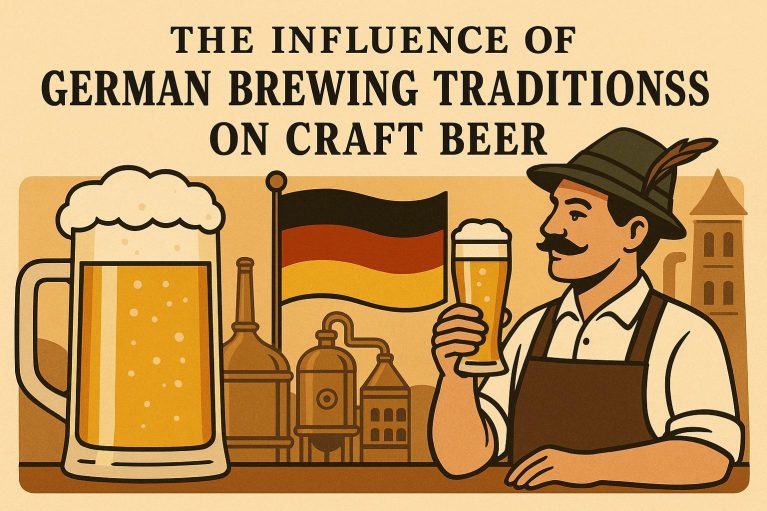The Origins of German Brewing Traditions
German brewing traditions have profoundly influenced the global beer industry, particularly as craft beer gains popularity worldwide. The story of German brewing can be traced back to the Middle Ages, a period that significantly shaped the brewing techniques and styles that emerged from the region. At the heart of this tradition is the Reinheitsgebot, or the Beer Purity Law of 1516. This regulation, one of the earliest food safety regulations known in the world, stipulated that only three ingredients—water, barley, and hops—could be used to brew beer. The stringent purity standards established by the Reinheitsgebot not only ensured a high quality for German beers but also helped define the distinct flavors and styles of German brews that are recognized globally today.
Key Characteristics of German Brews
German beers are known for their strong adherence to traditional brewing methods and the use of high-quality ingredients. This dedication to tradition is evident in some of the most popular beer styles that have originated from Germany, including Lager, Pilsner, and Weissbier (wheat beer).
Lager, a type of beer that ferments at lower temperatures, is celebrated for its clean and crisp flavor profile. This lower fermentation temperature results in a smooth and refreshing beer that has broad appeal. The Pilsner, a specific type of pale lager that originated in the city of Pilsen, is distinguished by its golden color and pronounced hop bitterness. This style’s balanced complexity has made it a favorite worldwide. Another popular German beer style is Weissbier, primarily made from wheat. It is famous for its cloudy appearance and spicy, fruity notes, offering a distinct alternative to other more conventional beer styles.
Influence on Craft Beer
The craft beer movement, which values diversity and creativity in brewing, owes a considerable debt to these German brewing traditions. Brewers worldwide have adopted and adapted these long-established German methods, leading to the creation of unique and varied beer offerings. The focus on quality ingredients and meticulous brewing processes inherent in German brewing is mirrored in the practices of many modern craft breweries.
Craft brewers often experiment with traditional German styles, sometimes introducing innovative twists to classical recipes. For instance, brewers in the United States may craft a Hefeweizen infused with additional fruit flavors, thereby adding a new dimension to the traditional wheat beer. Similarly, an India Pale Lager might be created to combine the hop-forward profiles typical of an IPA with the clean and crisp characteristics of lager.
Education and Innovation
International interest in German brewing techniques has ignited increased educational exchanges and collaborations. Many aspiring brewers from all corners of the globe travel to Germany to study its brewing methodologies. These aspiring brewers often enroll in well-regarded institutions such as the Doemens Academy and VLB Berlin. These schools offer an education that encompasses both traditional methods and innovative approaches, encouraging brewers to respect tradition while also pushing the boundaries of what beer can be.
The dynamic interaction between German brewing traditions and modern craft beer practices is most evident during festivals and competitions. Events such as the Oktoberfest and the Great American Beer Festival celebrate both traditional and contemporary beer styles, fostering a cultural exchange that enriches the global beer landscape and allows for an open dialogue between old and new practices.
Preserving Tradition in Modern Times
As the craft beer movement continues to grow and evolve, the respect for traditional German brewing methods remains a constant influence. Beers that adhere to the stringent requirements of the Reinheitsgebot are still highly regarded. Many craft brewers strive to honor these historical traditions even as they experiment with new flavors and techniques. These German brewing practices continue to serve as a cornerstone of global beer culture, ensuring the sustained influence of German brewing on the industry.
Moving forward, it is likely that the craft beer movement will continue to respect and draw inspiration from German brewing traditions. The balance between tradition and innovation remains an enriching factor in beer culture, promising new and exciting experiences for enthusiasts around the world. Whether it is a traditional German brew or a new craft creation inspired by time-honored methods, the influence of German brewing is profound and ongoing.
Conclusion
In conclusion, German brewing traditions have left an indelible mark on the global beer industry. The roots of these practices can be traced back to the Middle Ages and are epitomized by the Beer Purity Law of 1516, which set the stage for the distinct styles and flavors of German beer. These traditions have significantly shaped the craft beer movement, encouraging brewers worldwide to adopt high-quality brewing practices and respect traditional methods while simultaneously fostering a spirit of innovation.
Educational exchanges and collaborations between brewers continue to emphasize the importance of adhering to quality and tradition while exploring new possibilities. Festivals and competitions that celebrate both traditional and contemporary styles demonstrate the lasting influence of German brewing traditions and their contribution to the vibrant and diverse beer culture we enjoy today. As the beer industry evolves, the enduring legacy of German brewing will undoubtedly continue to inspire future generations of brewers and beer enthusiasts worldwide.

